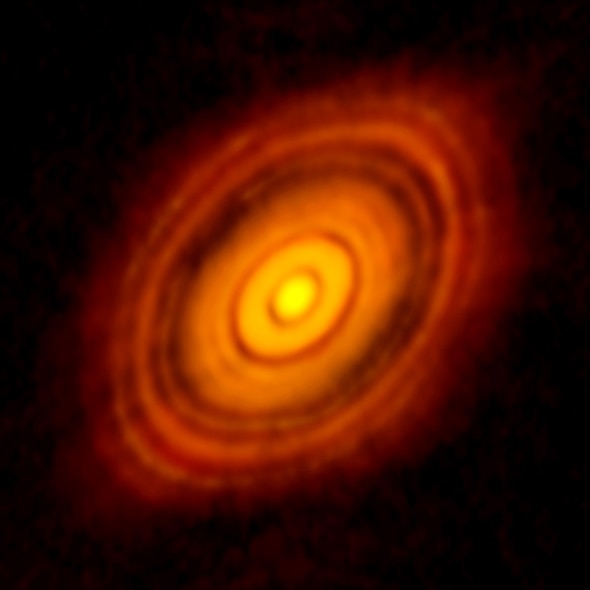Create a free profile to get unlimited access to exclusive videos, sweepstakes, and more!
A Dusty Disk Heralds the Birth of a New Solar System

I’ve studied newborn planetary systems off and on for quite some time now, including working on high-resolution Hubble observations of young nearby stars, so please listen when I say that this is the most amazingly detailed and beautiful image of a nascent solar system I have ever seen.
That is the dusty disk surrounding the star HL Tau, a very young orange dwarf star about 450 light-years away. And I do mean young; it’s only about a million years old—the Sun is 4.6 billion years old, so this star is barely out of the womb. In fact, it’s not even really out of the womb: It’s still surrounded by a thick cocoon of gas and dust that completely hides it from the view of optical telescopes.
But this image was taken by ALMA, the Atacama Large Millimeter/submillimeter Array, a collection of over a dozen telescopes that can combine their power to achieve stunning resolution on distant objects. ALMA looks in the part of the spectrum between long radio waves and shorter infrared light. Warm dust glows brightly at these wavelengths, and can penetrate the thick shroud of material surrounding HL Tau’s disk.
The image of the disk is astonishing. We know that stars form from disks of gas and dust. The center of the disk is where material is most compressed by gravity, forming the new star. Outside that, the material can condense and form planets. We’ve seen this in other systems, but this new image shows the results of multiple planets: the gaps in the disk.
As a forming planet orbits the star, it sweeps up material in the disk via its gravity, carving a gap. Other gaps can form where the orbits of particles in the disk are simple multiples of the orbits of the planets; for example, where the dust closer in to the star orbits in exactly half the time as the planet. This is why Saturn’s rings have so many gaps in them.
The ALMA image of HL Tau’s disk is hot off the array, and there’s no paper published about it yet. I’ll be very curious to see some analysis of the image, including computer modeling of the disk to see how many planets can create this configuration. From the look of the gaps, I’d guess at least three, but that is just a guess.
What’s of perhaps greater interest is that there are any planets at all. From what we understand of planet formation, a star and disk this young shouldn’t have a planetary system evolved enough to create these gaps. That’s a bit of a shock. Research published in 2008 also indicated the presence of a new planet, and I’ll be curious to see how this new observation fits in with that work as well.
ALMA has been putting in an outstanding performance over the past few years, observing young stellar systems, dying stars (seriously, click that for a healthy dose of joyous amazingness), stars that went boom, and much more. The dishes comprising the array can be physically moved to achieve different results, and the HL Tau image is the first one from a new configuration that has the telescopes separated by an incredible 15 kilometers, giving it extremely high resolution (the farther apart the telescopes are, the more detail they can see). The images will get even better in the future when it observes in shorter wavelengths of light (which, due to the nature of light, naturally makes for higher resolution observations).
One of the most exciting aspects of astronomy is studying some class of objects, and watching as better technology comes along and unveils previously hidden wonders … and also provides even more mysteries for us to investigate.














